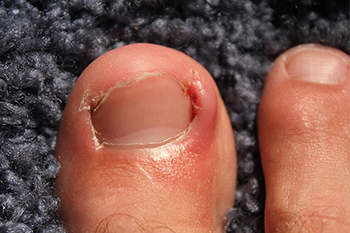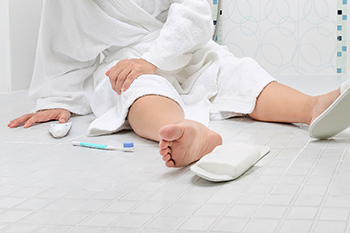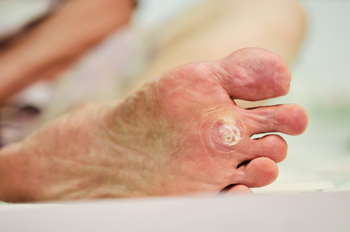Items filtered by date: November 2023
Ingrown Toenails and Infection Control

Ingrown toenails, a common condition where the nail grows into the toe's skin, can lead to infections if not properly managed. They most often affect the big toe and can result from trauma, improper nail trimming, and wearing tight footwear. The skin surrounding the ingrown nail becomes red, swollen, and painful, and may produce pus, indicating an infection. Preventing infection in ingrown toenails involves proper foot hygiene and nail care. Toenails should be cut straight across, avoiding rounding the corners which can encourage the nail to grow into the skin. Wearing properly fitting shoes that provide enough space for the toes to wiggle freely in can also reduce the risk. If you have an ingrown toenail and suspect an infection, it is strongly suggested that you make an appointment with a podiatrist for an evaluation and treatment.
Ingrown toenails may initially present themselves as a minor discomfort, but they may progress into an infection in the skin without proper treatment. For more information about ingrown toenails, contact Cory Brown, DPM of Cory Brown, DPM. Our doctor can provide the care you need to keep you pain-free and on your feet.
Ingrown Toenails
Ingrown toenails are caused when the corner or side of a toenail grows into the soft flesh surrounding it. They often result in redness, swelling, pain, and in some cases, infection. This condition typically affects the big toe and may recur if it is not treated properly.
Causes
- Improper toenail trimming
- Genetics
- Improper shoe fitting
- Injury from pedicures or nail picking
- Abnormal gait
- Poor hygiene
You are more likely to develop an ingrown toenail if you are obese, have diabetes, arthritis, or have any fungal infection in your nails. Additionally, people who have foot or toe deformities are at a higher risk of developing an ingrown toenail.
Symptoms
Some symptoms of ingrown toenails are redness, swelling, and pain. In rare cases, there may be a yellowish drainage coming from the nail.
Treatment
Ignoring an ingrown toenail can have serious complications. Infections of the nail border can progress to a deeper soft-tissue infection, which can then turn into a bone infection. You should always speak with your podiatrist if you suspect you have an ingrown toenail, especially if you have diabetes or poor circulation.
If you have any questions, please feel free to contact our office located in Lewiston, ID . We offer the newest diagnostic and treatment technologies for all your foot care needs.
Are You Suffering From Nerve Damage?
Effective Fall Prevention Strategies for the Home

Preventing falls at home is essential for maintaining safety, especially for seniors or those with mobility challenges. You can take several steps to create a safer living environment. Begin by evaluating your home for potential hazards, paying close attention to loose rugs, clutter, and uneven surfaces. Ensure that walkways are clear, and keep frequently used items within easy reach. It is helpful to install handrails and grab bars in critical areas such as bathrooms and staircases that can provide essential support. Having adequate lighting is important so make sure that rooms and hallways are well-lit, with light switches easily accessible. Consider using non-slip mats in the bathroom and kitchen to reduce the risk of slipping. Furniture arrangement also plays a role, and it is beneficial to have it arranged in a style that can create clear pathways and ensure stability. Wearing supportive footwear with non-slip soles is essential, as it can greatly reduce the risk of falls. Additionally, staying physically active and maintaining muscle strength can improve balance and coordination, making falls less likely. Falling can greatly impact the feet, and it is suggested that you visit a podiatrist who can help you implement successful fall prevention strategies.
Preventing falls among the elderly is very important. If you are older and have fallen or fear that you are prone to falling, consult with Cory Brown, DPM from Cory Brown, DPM. Our doctor will assess your condition and provide you with quality advice and care.
Every 11 seconds, an elderly American is being treated in an emergency room for a fall related injury. Falls are the leading cause of head and hip injuries for those 65 and older. Due to decreases in strength, balance, senses, and lack of awareness, elderly persons are very susceptible to falling. Thankfully, there are a number of things older persons can do to prevent falls.
How to Prevent Falls
Some effective methods that older persons can do to prevent falls include:
- Enrolling in strength and balance exercise program to increase balance and strength
- Periodically having your sight and hearing checked
- Discuss any medications you have with a doctor to see if it increases the risk of falling
- Clearing the house of falling hazards and installing devices like grab bars and railings
- Utilizing a walker or cane
- Wearing shoes that provide good support and cushioning
- Talking to family members about falling and increasing awareness
Falling can be a traumatic and embarrassing experience for elderly persons; this can make them less willing to leave the house, and less willing to talk to someone about their fears of falling. Doing such things, however, will increase the likelihood of tripping or losing one’s balance. Knowing the causes of falling and how to prevent them is the best way to mitigate the risk of serious injury.
If you have any questions, please feel free to contact our office located in Lewiston, ID . We offer the newest diagnostic and treatment technologies for all your foot care needs.
HPV Strains and Plantar Warts

Human Papilloma Virus, or HPV, is a large family of viruses, with over 150 types, and it is common for individuals to contract at least one type during their lifetime. Symptoms vary depending on the HPV strain, and while approximately 75 percent of HPV types cause common warts, others lead to more serious conditions. Often, HPV shows no symptoms, making some of its effects silent. For instance, plantar warts are a lesser known manifestation of HPV. They develop under the pressure points of the feet, such as the heels or the balls of the feet, and can be identified by their hard, grainy texture. Although they can be painful due to their location, some individuals may not notice them if they are not causing discomfort. It is advisable to examine your feet regularly, checking for any new growths or changes, including warts, as they could indicate an HPV infection. If you find you have a wart on your foot, it is suggested that you make an appointment with a podiatrist to have it examined and treated as necessary.
Plantar warts can be very uncomfortable. If you need your feet checked, contact Cory Brown, DPM from Cory Brown, DPM. Our doctor will assist you with all of your foot and ankle needs.
About Plantar Warts
Plantar warts are the result of HPV, or human papillomavirus, getting into open wounds on the feet. They are mostly found on the heels or balls of the feet.
While plantar warts are generally harmless, those experiencing excessive pain or those suffering from diabetes or a compromised immune system require immediate medical care. Plantar warts are easily diagnosed, usually through scraping off a bit of rough skin or by getting a biopsy.
Symptoms
- Lesions on the bottom of your feet, usually rough and grainy
- Hard or thick callused spots
- Wart seeds, which are small clotted blood vessels that look like little black spots
- Pain, discomfort, or tenderness of your feet when walking or standing
Treatment
- Freezing
- Electric tool removal
- Laser Treatment
- Topical Creams (prescription only)
- Over-the-counter medications
To help prevent developing plantar warts, avoid walking barefoot over abrasive surfaces that can cause cuts or wounds for HPV to get into. Avoiding direct contact with other warts, as well as not picking or rubbing existing warts, can help prevent the further spread of plantar warts. However, if you think you have developed plantar warts, speak to your podiatrist. He or she can diagnose the warts on your feet and recommend the appropriate treatment options.
If you have any questions please feel free to contact our office located in Lewiston, ID . We offer the newest diagnostic and treatment technologies for all your foot and ankle needs.
Managing Intoeing in Children's Feet

One foot condition parents may encounter in their child’s feet is known as metatarsus adductus, recognizable when a child's foot looks like it's forming a C shape. Known by other names, such as metatarsus varus or pes adductus, it is a condition your child might have from birth. The front part of the foot, or the forefoot, points inward toward the back part of the foot. This makes the inside edge of the foot look curved and the outside edge look more rounded. Metatarsus adductus can be confused with other foot problems like skewfoot, which has a bump on the outside edge, or clubfoot, where the whole foot is turned inwards and down. Sometimes, this condition fixes itself as your child grows, but regular check-ups with a podiatrist are essential for monitoring progress. This medically trained foot doctor can suggest simple stretching exercises to help the foot align correctly. In addition, your podiatrist can prescribe custom shoe inserts for extra support and help correct the foot's shape. In more severe cases, your child's foot might be gently cast to guide it into the right position. Surgery may be suggested in extreme cases. With the right care and guidance, your child can have happy, healthy feet. If your child exhibits intoeing, it is suggested that you make an appointment with a podiatrist for a complete examination and a treatment plan.
Congenital foot problems require immediate attention to avoid future complications. If you have any concerns, contact Cory Brown, DPM of Cory Brown, DPM. Our doctor can provide the care you need to keep you pain-free and on your feet.
Congenital foot problems are deformities affecting the feet, toes, and/or ankles that children are born with. Some of these conditions have a genetic cause while others just happen. Some specific foot ailments that children may be born with include clubfeet, polydactyly/macrodactyly, and cleft foot. There are several other foot anomalies that can occur congenitally. What all of these conditions have in common is that a child may experience difficulty walking or performing everyday activities, as well as trouble finding footwear that fits their foot deformity. Some of these conditions are more serious than others. Consulting with a podiatrist as early as possible will help in properly diagnosing a child’s foot condition while getting the necessary treatment underway.
What are Causes of Congenital Foot Problem?
A congenital foot problem is one that happens to a child at birth. These conditions can be caused by a genetic predisposition, developmental or positional abnormalities during gestation, or with no known cause.
What are Symptoms of Congenital Foot Problems?
Symptoms vary by the congenital condition. Symptoms may consist of the following:
- Clubfoot, where tendons are shortened, bones are shaped differently, and the Achilles tendon is tight, causing the foot to point in and down. It is also possible for the soles of the feet to face each other.
- Polydactyly, which usually consists of a nubbin or small lump of tissue without a bone, a toe that is partially formed but has no joints, or an extra toe.
- Vertical talus, where the talus bone forms in the wrong position causing other bones in the foot to line up improperly, the front of the foot to point up, and the bottom of the foot to stiffen, with no arch, and to curve out.
- Tarsal coalition, when there is an abnormal connection of two or more bones in the foot leading to severe, rigid flatfoot.
- Cleft foot, where there are missing toes, a V-shaped cleft, and other anatomical differences.
- Macrodactyly, when the toes are abnormally large due to overgrowth of the underlying bone or soft tissue.
Treatment and Prevention
While there is nothing one can do to prevent congenital foot problems, raising awareness and receiving neonatal screenings are important. Early detection by taking your child to a podiatrist leads to the best outcome possible.
If you have any questions please feel free to contact our office located in Lewiston, ID . We offer the newest diagnostic tools and technology to treat your foot and ankle needs.

